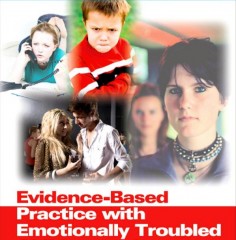
Evidence-Based Practice with Emotionally Troubled Children and Adolescents
Author: Morley D. Glicken, DSW.
Elsevier 2009, ISBN: 978-0-12-374523-1
At a time when increasing numbers of children are being treated for emotional problems, naming and treating those problems remains more of an art than a science often leaving children and their parents to navigate a confusing path. One reason for this uncertainty is that we have few objective ways of assessing a child’s emotional difficulties other than judgments based on interviews and checklists of symptoms. Unlike most adults, however, young children are often unable or unwilling to talk about their symptoms, leaving mental health professionals to rely on observation and information from parents and teachers that may be incorrect or biased. Furthermore, children develop so quickly that what looks like attention deficit disorder in the fall may look like anxiety or nothing at all in the summer. Although the mental health field has made great strides in helping children manage mental illness, particularly moderate conditions, the system of diagnosis is still ‚200 to 300 years behind other branches of medicine‘, according Dr. E. Jane Costello, a professor of psychiatry and behavioral sciences at Duke University. Dr. Costello and other experts believe that the search for a diagnosis is often a process of trial and error that may end with serious errors in diagnosis and treatment. According to government surveys at least six million American children have difficulties that are diagnosed as serious mental disorders, a number that has tripled since the early 1990s even though one of the largest continuing surveys of mental illness in children, tracking 4,500 children ages 9 to 13, found no cases of full-blown bi-polar disorder and only a few children with the mild flights of excessive energy that could be considered nascent bipolar disorder. Moreover, the symptoms diagnosed as serious emotional problems in children often bear little resemblance to those in adults. Instead, children’s moods often flip on and off throughout the day, and their upswings often look more like extreme agitation than bi-polar disorder. The confusion over accurate diagnosis and treatment leaves parents with very difficult children virtually alone and confused by the conflicting signals given by doctors and other mental health professionals. If parents are lucky, they may find a specialist who listens carefully and has the sensitivity to understand their child and their family. In dozens of interviews conducted by the author, however, parents of troubled children said that they had searched for months and sometimes years to find the right therapist. The advantage of EBP, according to Hines, is that it allows the practitioner to develop quality practice guidelines that can be applied to the client, identify appropriate literature that can be shared with the client, communicate with other professionals from a knowledge-guided frame of reference and, continue a process of self-learning that results in the best possible treatment for clients. Focusing on the most current research and best evidence regarding assessment, diagnosis, and treatment of children and adolescents with a range of emotional problems including, but not limited to: ADHD; Bi-Polar Disorder; anxiety and depression; eating disorders; Autism; Aspirgers Syndrome; substance abuse; social isolation; school related problems including underachievement; sexual acting out; Oppositional Defiant and Conduct Disorders; Childhood Schizophrenia; Gender Issues; Prolonged Grief; gang involvement; and, a number of other problems experienced by children and adolescents. Because concrete research evidence is often not used as the basis for practice with children and adolescents, and the next edition in the „DSM“ series, which promises more information about children isn’t due until 2011, Evidence-Based Practice with Emotionally Troubled Children and Adolescents provides a timely guide for practitioners, students, mental health professionals, and parents to a research-oriented approach for understanding and helping children experiencing emotional difficulties and their families. Particularly in populations where there has been a dramatic increase in troubled youth such as autism and substance abuse. The problems discussed in Evidence-Based Practice with Emotionally Troubled Children and Adolescents range from more common problems such as underachievement and parents who fail to supervise or provide effective role models to much more serious problems including Bi-Polar Disorder, Borderline Personality Disorder, and children traumatized by sexual abuse, violence, and neglect. Evidence-Based Practice with Emotionally Troubled Children and Adolescents fully covers assessment, diagnosis & treatment of children and adolescents, focusing on evidence-based practices; offers detailed how-to explanation of practical evidence-based treatment techniques; and, cites numerous case studies and provides integrative questions at the end of each chapter. Material related to diversity (including race, ethnicity, gender and social class) is integrated into each chapter.